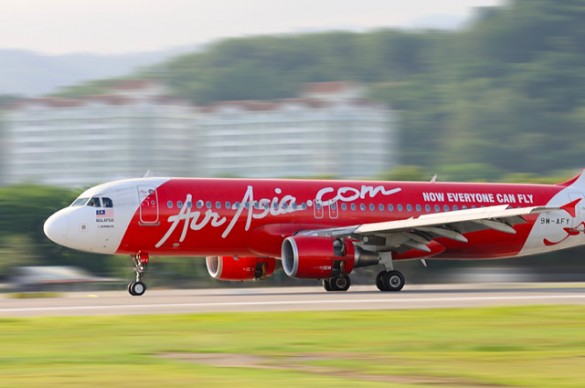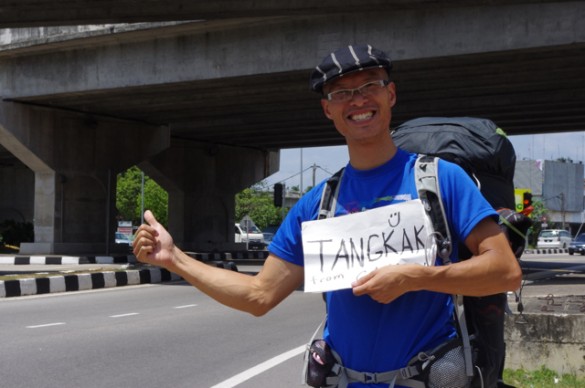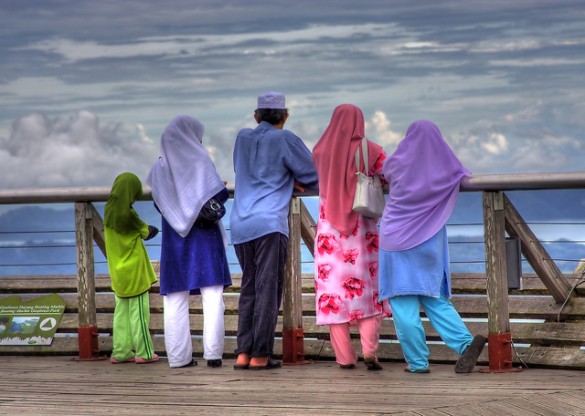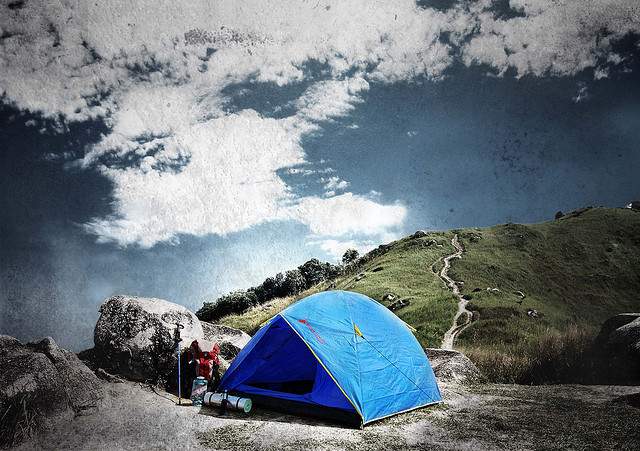Malaysia has a well-deserved reputation for being friendly and accessible to travelers. There’s a lot of wildlife to see, and the interaction of race, culture, and politics is mesmerizing. Compared to other parts of Southeast Asia; however, Malaysia can also be much harder on wallets. If you’ve been thinking of visiting but have balked at the cost, I recently toured Malaysia for one month on $10USD a day. Granted, hitchhiking in the back of lorries, couchsurfing with strangers, and tenting in jungles are not everyone’s cup of tea – but the further you step away from your comfort zone, the more you’ll see of Malaysia’s inner life.
Transportation

Get into Malaysia by plane
Air Asia, a no-frills short-haul airline based in Malaysia, has become a game-changer for Asian tourism. Recent bargain priced Air Asia flights include Kuala Lumpur to Tokyo for $138 (but twice that amount in the opposite direction), and Kuala Lumpur to Phuket for $70. Air Asia flies into Kuala Lumpur via a different airport (Low Cost Carrier Terminal, LCCT) from the one used by other airlines (Kuala Lumpur International Airport, KLIA). At KLIA, there’s a very fast and convenient train that whisks you into Kuala Lumpur (12 USD, 30 minutes). At LCCT, by contrast, make your way to the far end of the terminal, where you can find frequent buses running to Kuala Lumpur (3 USD, 1.5 hour trip). Young men, wearing the shirts of the bus companies, lounge outside the buses and sell tickets for the buses – seems a little sketchy at first, especially in the dark, but the procedure is legit and safe.
Check out flights to Kuala Lumpur
Get into Malaysia by train
Another option is to catch a train from Thailand or Singapore into Malaysia. The train allows you to wander about coaches and chat with neighbors at leisure – and plenty of leisure is what you’ll have, as the creaky old locomotive dawdles behind published schedule. A seat in a 2nd class coach from Hat Yai to Kuala Lumpur will set you back $15 (12 – 13 hours), with a change of trains at the Malaysia/Thailand border, and once again in Butterworth. With the recent bombing in Hat Yai on March 31, 2012; however, many tourists will avoid this route.
[social]
Get into Malaysia by boat
Alternatively, catch a boat from Satun, on the south-west coast of Thailand, to the Malaysian island of Langkawi for $10 (75 minutes), and then make your way by boat to Penang ($20, 2 hours 45 minutes) or Kualah Kedah ($7, 1 hour 45 minutes). Of course, more adventurous and unusual routes are possible – cycling, motorcycling, walking, sailing, kayaking, etc. If you found a brilliant way to reach Malaysia, let us know!
Get around Malaysia by hitchhiking or bus

Many Malaysians avow that it is impossible to hitchhike in their country. In fact, I often found it easier to hitchhike in Malaysia than in industrialized countries like Japan or Canada. A motorcyclist in Muar once stopped to advise me to take a bus; five minutes after he left, three cars pulled up simultaneously with drivers offering me a ride.
The usual safety precautions with hitchhiking should be observed, and then there are the extra discomforts of baking in the searing Malaysian sun or being inundated by monsoon downpour, or simply feeling like a dolt as traffic whizzes by. Most drivers will speak at least a little English. If it seems that drivers simply aren’t interested in taking you to your destination, be patient: a duo on a motorcycle has assaulted more than 20 women with acid attacks around Kuala Lumpur in recent months, jacking up the paranoia level a notch or two.
For more conventional means of travel, Malaysian buses are cheap and fast – a 2 hour ride from Kuala Lumpur to Melaka is about $4, and depart from vast, spanking new B’spadu Selatan Station. Sri Maju is an efficient bus line that plies routes north of Kuala Lumpur in spacious new coaches; ex. Kuala Lumpur to Ipoh ($5, 2 hours 20 minutes), and Ipoh to Butterworth ($5, 2 hours 30 minutes). Sri Maju operates a tidy station in Ipoh at Jalan Bendahara, rather than using the sordid isolated station at Medan Gopeng currently accessed by other bus lines.
How to dress for Malaysia

When planning your wardrobe, keep in mind that modesty is often expected for Malaysian Muslim women. Valentine’s Day sees Islamic watchers scouting for misbehaving would-be lovers. On the other hand, true to its reputation as an icon of progressive Islam, Malaysia offers relative freedom to non-Muslim Malaysians and foreigners.
For Malaysia’s hot and sticky climate, dark-colored quick-dry pants with built-in waist belt and zipper pockets, and that convert into shorts with zip-off legs, work well for guys; girls can do the same or opt for shorts and a skirt wrap. Make sure zippers are big and robust. I picked up a pair of smart Montbell pants in Japan for $100, and they lasted me for six months before the zipper on the zip-off pant leg broke. Not bad for daily use over six months of traveling. Langkawi and other resorts give tourists a chance to don Western-style casual beach clothing.
Stay dry, stay happy
Quick-dry underpants are worth the extra price for convenience and comfort on the go. Thong-style flip-flops keep your feet drier and less smelly than sandals with straps, but on the other hand, the straps can help in river crossings.
A little bottle of baby powder also helps beat the humidity and can be sprinkled on your feet, etc. I really like Johnson and Johnson’s small bottles of baby powder. They’re compact, rugged, and come with a convenient twist lid. Gold Bond is also great for when you get heat rashes in those uncomfortable areas.
Handy fold-up umbrellas ward off rain and sun. I picked up a used fold-up umbrella in Japan for $5 at a pawn shop. Backpack covers and ziploc bags are essential for keeping your gear dry in Malaysia’s persistent rainfall. Bright colored covers can help you in hitchhiking as well, or in spotting your covers if they blow away from your tent site.
Check out our Malaysia Indie Travel Guide
Accommodations in Malaysia

Couchsurfing Malaysia
Couchsurfing.org, a website that links travelers with locals or other travelers, is not as popular in Malaysia as it is in Europe or North America, but with perseverance and ingenuity, you can find free accommodations for your entire stay in Malaysia.
Tips for couchsurfing in Malaysia: Politics is a touchy subject to discuss in Malaysia, a country that is struggling to make the transition from authoritarian to multi-party democracy. Race and religion are deeply divisive in Malaysia, though luckily these issues have not been as incendiary as in neighboring Indonesia. On the whole, it is easy to find topics that will get Malaysians riled – the domestic car monopolies and corruption-riddled transportation projects are also universal irritants – and much harder to find subjects that Malaysians enjoy discussing.
If you’re ever stuck for a topic, talk about food. You will likely never encounter a country where eating is discussed and celebrated with as much passion as in Malaysia. Spend hours arguing over and admiring the merits of Bak Kut Teh (pork rib and garlic soup, renowned in Klang), Roti bread and its constellation of accompanying Dals (lentil paste), variants of the fried rice dish known as Nasi Goreng, or the proper consistency for meat skewers (Satay).
As one of my Malaysian hosts observed, “If you want to understand Malaysia, you should study its food… When [we] get depressed, we turn to food.”
Free camping in Malaysia: Endau Rompin National Park
Though most Malaysians are unaware of it, the countryside offers numerous opportunities for free or nearly free camping. A visit to Endau Rompin National Park, at the border of Johor and Pahang states, officially starts at $100 a day, including a guide, but you can opt instead to camp for free at the falls just at the edge of the park (Air Terjun, 7 km from park entrance at Bekok, hitchhikable); basic bathroom facilities and hawker stands are clustered near the falls entrance, and a few wooden shelters have been set up along the river, useful for cooking and drying clothes in the rain. A self-guided trail snakes upward along the river, but the path is not always marked well. Be prepared for swarms of leeches.
Free camping in Malaysia: Gunung Ledang
Gunung Ledang, an hour’s drive west of Melaka, is a popular mountain park with a refreshing creek. Just above the falls (30 minute hike), you can camp for free, but dig your own potty far from the river, or better still, pack our your waste. There is a moderately challenging trail winding upstream along the river, which can be followed for a day’s hike. Two hours up the trail, you’ll reach a quiet abandoned campsite with pools full of small fish that nibble at your feet.
Free camping in Malaysia: Gunung Datuk
At Gunung Datuk, a mountain halfway between Kuala Lumpur and Melaka, you can camp on the peak (2.5 hour hike). Haul your own water, as there are no springs on the top. Black-faced gibbons lounge in treetops at amazingly close range. The peak of Gunung Datuk is known for offering dramatic views of the countryside.
Almost free camping in Malaysia: Taman Negara
The granddaddy of all jungles in Malaysia, Taman Negara, has campsites for $2 per night, serviced by a spacious kitchen and cold showers. The campground is frequented by elephants, boars, pheasants, barking deer, macaques, and a dazzling assortment of insects and birds that will keep you running for the camera. Keep your food in the kitchen, but make sure your food is in a sealed container, since birds can get through the wire mesh and will happily peck away at your stash! A half hour’s hike along a trail north of the campsite brings you to a bend in the river where you can swim amid towering hardwood trees (warning: at the time of writing, the boardwalk to the swimming area is still under construction, and the pathway next to it can be very slippery and muddy, so walk cautiously). If you proceed further down this trail (5 hour loop back to campsite), you may glimpse hornbills; you’ll also get a chance to traverse the forest canopy on rope bridges.
DEET mosquito repellent allows you to retain sanity in the jungles. Citronella-based repellents may appear offer fewer side effects, but need to be re-applied frequently.
Find a hostel in Malaysia
Volunteering in Malaysia: the great garbage clean-up
Camping and hiking in Malaysia will give you rewarding views of wildlife. However, along with the wildlife, you will also get a front-seat view of garbage – a depressing abundance of garbage – scattered through the fragile nature preserves of Malaysia. What can tourists do about the garbage? Rather than just complain about it, you can help to organize a garbage clean-up!
In Muar, a town just south of Melaka, a couchsurfer host and I decided we would do our best to clean up the riverside park right next to the Sultan’s river-view home. We visited a Chinese high school and a public Malaysian high school and asked them for help in cleaning up the garbage. We fixed a date. Next, we got help from the Tzu-Chi Foundation, a large Buddhist community group with headquarters in Taiwan. The Tzu-Chi Foundation provided us with garbage bags and offered to take away the garbage to their recycling facility after the event.
We printed out our project proposal and took it to the Muar police department for approval. My couchsurfing friend, who owns the atmospheric Little Cafe in central Muar, made up sandwiches – a lot of them! One for each of the 170 participants. All the students and adult participants gathered on a Saturday morning and cleaned up the riverside, hauling away 80 kg of garbage, 50 kg of it plastic (argh!). Afterward, we chatted to the students about the garbage problem, about recycling options, about ideas to change attitudes, etc. Besides cleaning up the unsightly garbage, we aimed to raise awareness among the younger generation, and create a spirit of we-really-can-fix-this-garbage-mess.
Read From Tourist to Agent of Change: What You Need to Know About Voluntourism
To read more about budget travel, check out the following articles:
- Cheap Travel vs. Budget Travel: There’s a Difference
- 8 Ways to Travel for Free on Your RTW
- How to Travel the World on $40 Per Day
- Five of the World’s Most Expensive Countries and How to Visit Them on the Cheap
- Budget Travel by Bike: Why It’s the Best (& How You Can Do It for $14 Per Day)
- Friends Without Clothes and Vagabonding Without Shame: Tips to Find the Real Japan
Photos by: fisher, theNictoyking, all others courtesy of the author and may not be used without permission
